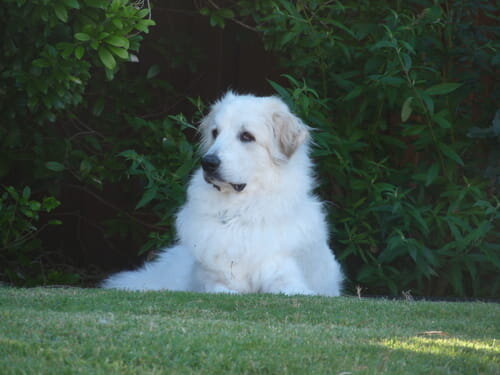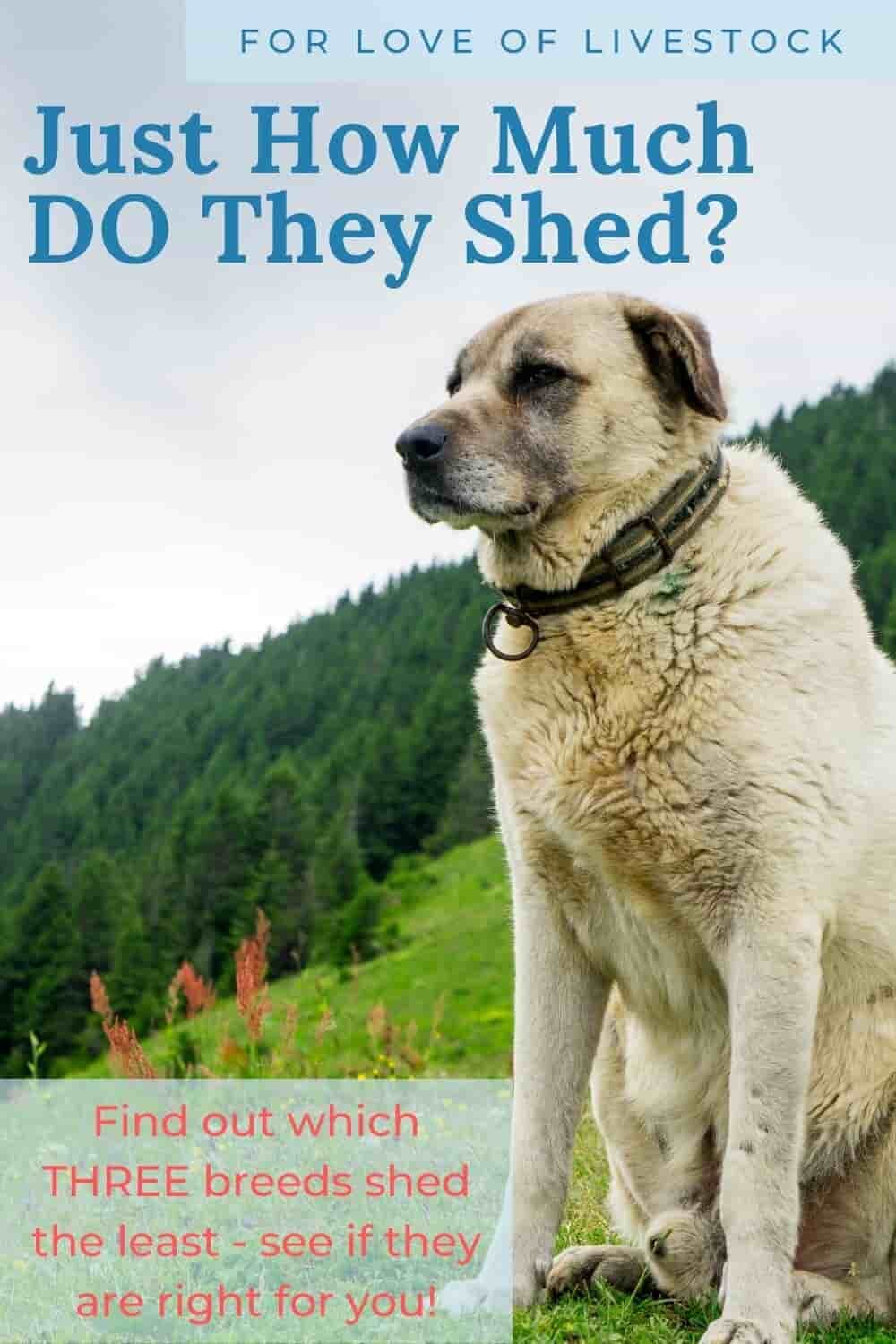LGDs and Shedding: Are There Any Hypoallergenic Livestock Guardian Dog Breeds?
Are you interested in getting a livestock guardian dog (LGD) breed to protect your animals, but you’re allergic to dogs? You may thinking that with so many hypoallergenic dog breeds out there, maybe some LGD breeds will be easy on your allergies to.
So, are there any livestock guardian dog breeds that are low in shedding and dander? No livestock guardian dog breeds are hypoallergenic, although some shed less than others. All breeds shed heavily twice a year, known as “blow outs,” but Kangals, Komondors, and Spanish Mastiffs tend to shed less between blow outs than do other breeds.
If your allergies are so severe you require a hypoallergenic breed, you won’t find any traditional LGD breeds to meet your needs. However, if your allergies are mild or moderate, some LGD breeds may work for you.
Check out the following chart to see which breeds shed the most, moderately, and the least.
| Heavy Shedding | Moderate Shedding | Light-Moderate Shedding |
|---|---|---|
| Akbash | Anatolian Shepherd | Kangal |
| Armenian Gampr | Central Asian Shepherd | Komondor |
| Great Pyrenees | Estrela Mountain Dog | Spanish Mastiff |
| Karakachan | Polish Tatra Sheepdog | |
| Kuvasz | Tibetan Mastiff | |
| Maremma Sheepdog | ||
| Pyrenean Mastiff | ||
| Sarplaninac | ||
| Slovensky Cuvac | ||
| Tornjak |
For more information on each breed and how much it sheds, check out the descriptions below.
Light to Moderately Shedding Livestock Guardian Dogs
Kangal Shepherd Dog
Depending on the severity and type of fur allergy, Kangals could be a better fit for families who have allergy concerns. They do heavily shed twice per year and need to be brushed a lot during those times. However, for the rest of the year, their shedding is kept to a minimum compared to other livestock guardian breed dogs.
Check out the video below of a Kangal dog during his spring blow out.
Komondors
Komondors shed as puppies, but once their fur becomes corded, they don’t shed that much. However, coat care is a challenge with Komondors as their cords have to be manually maintained.
Like all LGDs, this breed’s undercoat is shed bi-annually and at this time, the cords have to be separated to make sure they don’t mat too close to the skin. Their cords also need to be trimmed at times to keep them from dragging along the ground and getting too dirty.
Other than that, the shedding is very minimal throughout the year. Because of this, Komondors could be a better option for allergy-prone humans.
For more information on grooming Komondors and maintaining healthy coats, check out the video below.
Spanish Mastiff
Spanish Mastiffs have a shorter, denser coat. They do shed heavily twice per year (like all livestock guardian dog breeds). However, because of their shorter fur and lighter shedding throughout the rest of the year, they may be a better option for those with allergy issues.
Below is a video of a Spanish Mastiff during a spring blow out.
Moderately Shedding Livestock Guardian Dogs
Anatolian Shepherd
Anatolian Shepherds shed small amounts of fur throughout the year. Twice per year, they blow out their coats and lose large clumps of fur. This can create quite the mess and is difficult to keep under control. Depending upon the severity of the allergy, and whether or not this dog will reside primarily inside or outside, this could be a better fit for families with allergies.
Below is a video showing how much hair an Anatolian Shepherd loses. The video is dated March 23rd, so I believe this is during the spring blow out.
Central Asian Shepherd Dog
This breed of dog is a seasonal shedder, and does not shed that much otherwise. However, during that season of shedding, they produce A LOT of fur, which could be problematic. If the dog is able to stay outside during that period of time, they might do okay with a family with allergy issues.
Check out the video below to see just how much fur a Central Asian Shepherd loses during a spring blowout.
Estrela Mountain Dog
There are two different varieties of Estrela Mountain Dogs—a short-haired and a long-haired variety. Both varieties of Estrela dogs shed most of the year, but very lightly. They also shed heavily during the changing of the seasons.
If you are looking at getting an Estrela Mountain Dog and are concerned about allergies, I’d highly recommended going with the short-haired variety. They still shed, but the fur is short so there isn’t as much dander build up or actual fur floating around. Unfortunately, I have not been able to a find a breeder of the short-haired variety in the United States.
Polish Tatra Sheepdog
Although Polish Tatras have longer, thicker coats, they actually don’t shed that much throughout the year. Unlike other livestock guardian dog breeds who require an almost daily brushing, these dogs only need to be brushed once a week or once every other week to maintain a healthy and minimally shedding coat.
However, this breed does shed a lot during the late spring and will need constant grooming during those times. Depending on the allergy severity, Tatras might be worth a shot.
Tibetan Mastiff
This breed has a double coat and lots of fur. However, their shedding is kept to a minimum throughout the year. The only time you’ll really have an issue with shedding is during their seasonal shed. At that time, you can expect lots of fur and dander around. Check out the video below to see the extent of their blow out.
However, because they shed during the warmer season, they could be kept outside a great deal of the time to minimize the effects on humans with allergies. Throughout the rest of the year, they likely wouldn’t cause too many issues.
Heavily Shedding Livestock Guardian Dogs
Akbash
The Akbash dog is not hypoallergenic and has a thick, medium length double coat. This means they not only seasonally shed, but they shed throughout the year as well.
To decrease off-season shedding, they should be brushed weekly. Because of their need to be brushed often and their tendency to shed in general, they may not be the best fit for families with allergies.
Armenian Gampr
Armenian Gamprs are not recommended for families with allergies. They shed regularly throughout the year and also shed heavily twice per year. They have long, dense coats which can cause dander and excess fur buildup. Even with regular grooming, allergies may flare up with this breed.
Great Pyrenees
Great Pyrenees dogs shed ALL THE TIME. This can be helped through regular brushing and grooming. However, the shedding never totally ceases. Because of this, they are not recommended for owners with allergies.
Check out the video below to get an idea on how much they shed.
Karakachan
These dogs have a longer, denser coat and therefore require quite a bit more brushing and grooming than other dog breeds. They do shed regularly and need to be brushed multiple times per week to reduce the amount of shedding and matting. They also shed even more heavily twice per year which can cause problems for people with fur and dander allergies.
Kuvasz
Because their fur is long and thick, Kuvasz need to be brushed a couple times per week to prevent mats and reduce the already high amount they tend to shed. They also have major seasonal blow outs, and shed a lot during this time. They may not be the best fit for a family that has dander and fur allergies.
Maremma Sheepdog
This breed sheds heavily throughout the year. They have a need to be brushed almost daily to keep shedding and matting under control. This can be an issue for people with allergies or issues with dander.
Pyrenean Mastiff
Pyrenean Mastiffs have a long double coat that sheds regularly. They will need brushing and handling several times per week to keep the shedding under control. They also heavily shed twice per year. They are not recommended for families with fur and dander allergies.
Sarplaninac
Sarplaninacs have a long, thick double coat that requires a lot of grooming and handling. They shed throughout the year but also heavily seasonally shed. If not properly and regularly brushed, they can build up a lot of dander and excess fur. These dogs are not recommended for families with fur and dander allergies.
Slovensky Cuvac
This breed has a very, very thick coat. They shed a TON. Grooming can be difficult because of their thick coat, so it really requires a lot of time and effort (and direct contact with fur and dander) to keep this dog in its prime. I would not suggest this breed for people with dander or fur allergies.
Tornjak
Tornjaks shed regularly and have a thick, wooly coat. They also heavily shed during the changing of the seasons. Their grooming needs are quite high, which would mean having to be in contact with a lot of fur and dander fairly consistently. I would not recommend this breed for families with allergy issues.
For information on grooming livestock guardian dogs, check out my grooming guide, Grooming Great Pyrenees and Other Livestock Guardian Dog Breeds: The Ultimate Guide.
You May Also Be Interested in:
Brain Training for Dogs: The Best Online Obedience Training Program for Livestock Guardian Dogs
Train Your Great Pyrenees to Stop Barking: When You Don’t Want Fido to ‘Speak’
Livestock Guardian Dogs and Roaming: Which Breeds Roam, Why, and How to Fix Roaming Problems
Male or Female Livestock Guardian Dogs: Which Is Better for Your Needs

